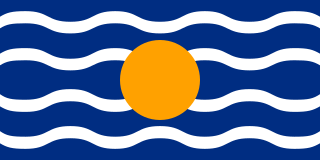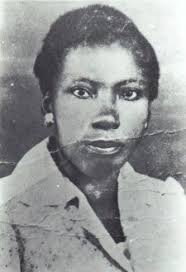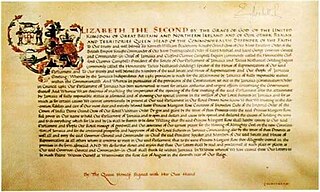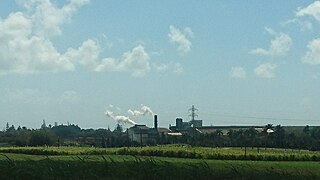Related Research Articles

British Guiana was a British colony, part of the mainland British West Indies, which resides on the northern coast of South America. Since 1966 it has been known as the independent nation of Guyana.

The West Indies Federation, also known as the West Indies, the Federation of the West Indies or the West Indian Federation, was a short-lived political union that existed from 3 January 1958 to 31 May 1962. Various islands in the Caribbean that were part of the British Empire, including Trinidad and Tobago, Barbados, Jamaica, and those on the Leeward and Windward Islands, came together to form the Federation, with its capital in Port of Spain, Trinidad and Tobago. The expressed intention of the Federation was to create a political unit that would become independent from Britain as a single state — possibly similar to Canada, the Federation of Australia, or the Federation of Rhodesia and Nyasaland. Before that could happen, the Federation collapsed due to internal political conflicts over how it would be governed or function viably. The formation of a West Indian Federation was encouraged by the United Kingdom, but also requested by West Indian nationalists.

The British West Indies (BWI) were colonised British territories in the West Indies: Anguilla, the Cayman Islands, Turks and Caicos Islands, Montserrat, the British Virgin Islands, Antigua and Barbuda, The Bahamas, Barbados, Dominica, Grenada, Jamaica, Saint Kitts and Nevis, Saint Lucia, Saint Vincent and the Grenadines, British Guiana and Trinidad and Tobago. Other territories included Bermuda, and the former British Honduras.

Coolie is a pejorative term used for low-wage labourers, typically those of Indian or Chinese descent.

Sir Vere Cornwall Bird, KNH was the first Prime Minister of Antigua and Barbuda. His son, Lester Bryant Bird, succeeded him as Prime Minister. In 1994, he was declared a "National Hero".

Sir Grantley Herbert Adams, CMG, QC was a Barbadian politician. He served as the inaugural premier of Barbados from 1953 to 1958 and then became the first and only prime minister of the West Indies Federation from 1958 to 1962. He was a founder of the Barbados Labour Party (BLP), and he was named in 1998 as one of the National Heroes of Barbados.
The British West Indies dollar (BWI$) was the currency of British Guiana and the Eastern Caribbean territories of the British West Indies from 1949 to 1965, when it was largely replaced by the East Caribbean dollar, and was one of the currencies used in Jamaica from 1954 to 1964. The monetary policy of the currency was overseen by the British Caribbean Currency Board (BCCB). It was the official currency used by the West Indies Federation The British West Indies dollar was never used in British Honduras, the Cayman Islands, the Turks and Caicos Islands, the Bahamas, or Bermuda.
Indo-Caribbeans or Indian-Caribbeans are people in the Caribbean who are descendants of the Jahaji indentured laborers from India and the wider subcontinent, who were brought by the British, Dutch, and French during the colonial era from the mid-19th century to the early 20th century. A minority of them are descendants from people who immigrated as entrepreneurs, businesspeople, merchants, engineers, doctors, religious leaders and other professional occupations beginning in the mid-20th century.

The Oilfields Workers' Trade Union (OWTU) is one of the most powerful trade unions in Trinidad and Tobago. Currently led by Ancel Roget, the union was born out of the 1937 labour riots, the union was nominally led by the imprisoned TUB Butler but was actually organised by lawyer Adrian Cola Rienzi.

Slavery in the British and French Caribbean refers to slavery in the parts of the Caribbean dominated by France or the British Empire.

The term British West Indies refers to the former English and British colonies and the present-day overseas territories of the United Kingdom in the Caribbean.
The Indian indenture system was a system of indentured servitude, by which more than 1.6 million workers from British India were transported to labour in European colonies, as a substitute for slave labor, following the abolition of the trade in the early 19th century. The system expanded after the abolition of slavery in the British Empire in 1833, in the French colonies in 1848, and in the Dutch Empire in 1863. British Indian indentureship lasted till the 1920s. This resulted in the development of a large South Asian diaspora in the Caribbean, Natal, East Africa, Réunion, Mauritius, Sri Lanka, Malaysia, Myanmar, and Fiji, as well as the growth of Indo-Caribbean, Indo-African, Indo-Mauritian, Indo-Fijian, Indo-Malaysian, and Indo-Singaporean populations.
This article describes the history of West Indies cricket to 1918.

The Crown Colony of Jamaica and Dependencies was a British colony from 1655, when it was captured by the English Protectorate from the Spanish Empire. Jamaica became a British colony from 1707 and a Crown colony in 1866. The Colony was primarily used for sugarcane production, and experienced many slave rebellions over the course of British rule. Jamaica was granted independence in 1962.
The Report of West India Royal Commission, also known as The Moyne Report, was published fully in 1945 and exposed the poor living conditions in Britain's Caribbean colonies. Following the British West Indian labour unrest of 1934–1939, the Imperial Government sent a royal commission to investigate and report on the situation while also offering possible solutions. Sahadeo Basdeo points to the commission's investigation in the West Indies as a turning point in colonial attitudes. The uprisings were not seen as unprovoked violence, as they had so often been framed in the past, but as a justified opposition to a pathetic existence. Members of the commission asserted that the resistance that disrupted the Caribbean was not a spontaneous uprising with lofty cause but rather a demand from the labouring class for better and less restrictive lives.

Elma Francois was an Africentric Socialist political activist who, on 14 October 1987, was declared as a "national heroine of Trinidad and Tobago". She had been described as one of the "vociferous Africentric activists" in the history of Trinidad and Tobago and in the Caribbean region. She was known for her pro-trade union, anti-war and anti-colonial work.

The Colony of Jamaica gained independence from the United Kingdom on 6 August 1962. In Jamaica, this date is celebrated as Independence Day, a national holiday.

Federal elections were held in the West Indies Federation for the first and only time on 25 March 1958. The result was a victory for the West Indies Federal Labour Party, which won 25 of the 45 seats in the House of Representatives.
The Indian community in Saint Kitts and Nevis is made up of Indo-Kittitians, Indo-Nevisians, non-resident Indians and persons of Indian origin. Indo-Kittitians and Indo-Nevisians are nationals of Saint Kitts and Nevis whose ancestry lies within the country of India. The community originated from the Indian indentured workers brought to Saint Kitts and Nevis by the British in 1861 and 1874 respectively. By 1884, most of the community had emigrated to Caribbean nations with larger Indian populations such as Trinidad and Tobago, Guyana and Suriname.

The Uba riots of 1937 or simply the Mauritian riots of 1937 refers to an outbreak of riots and civil disturbances that broke out amongst small scale sugar cane growers on the island of Mauritius in August 1937. The riots led to the death of 4 people with an additional 6 people being injured.
References
- Brereton, Bridget, and Yelvington, Kevin A. The Colonial Caribbean in Transition. University Press of Florida (1999), ISBN 0-8130-1696-7
- Brown, Judith M., et al. The Oxford History of the British Empire. Oxford University Press (2000), ISBN 0-19-820564-3
- Canterbury, Dennis C. Neoliberal Democratization and New Authoritarianism. Ashgate Publishing, Ltd. (2005), ISBN 0-7546-4347-6
- Lisowski, Joseph. Environment and Labor in the Caribbean. Transaction Publishers (1992), ISBN 1-56000-584-X
- Paravisini-Gebert, Lizabeth. Phyllis Shand Allfrey: A Caribbean Life. Rutgers University Press (1996), ISBN 0-8135-2265-X
- Weiner, Myron and Özbudun, Ergun. Competitive Elections in Developing Countries. Duke University Press (1987), ISBN 0-8223-0766-9